梶原由景とPOGGYが別注したLOOPWHEELERはイメージ覆す”ヴィンテージ”がコンセプト、究極の“後付けパーカ”誕生の裏側
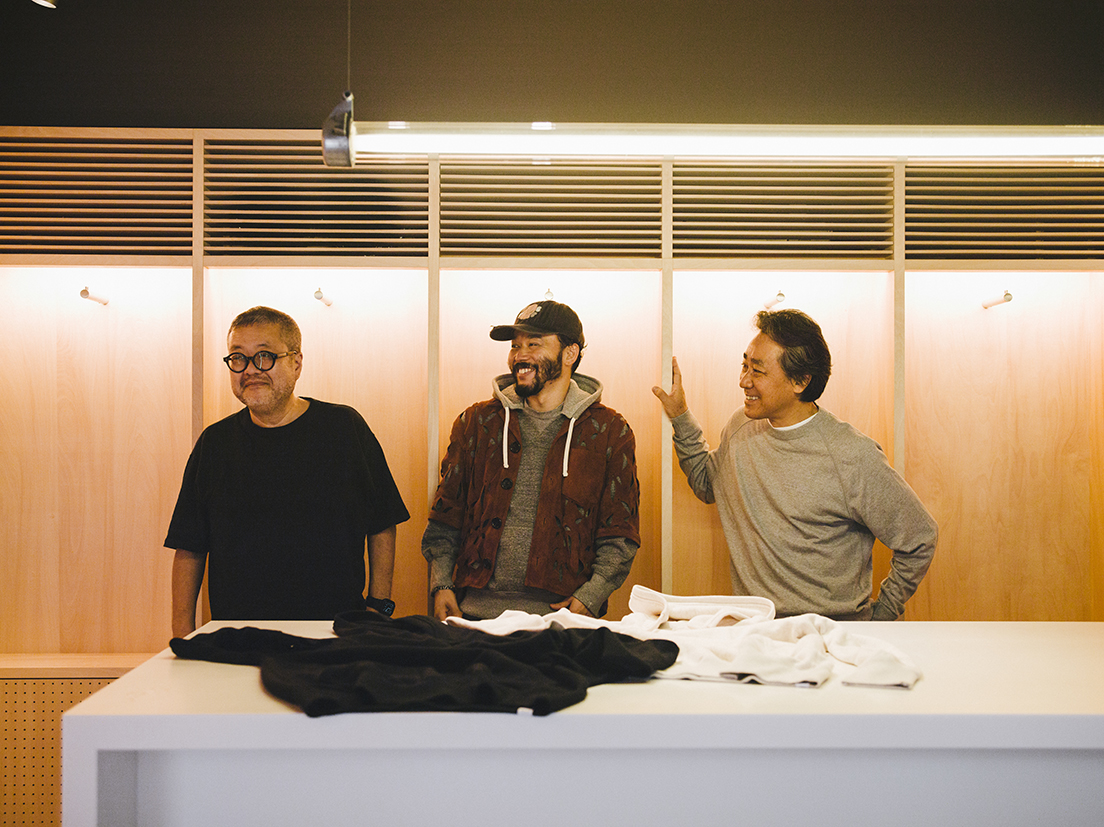
LOWERCASEの梶原由景と、“吊り編みスウェット”を世に広めた立役者「LOOPWHEELER(ループウィラー)」の鈴木諭の名タッグに、ファッションキュレーターの小木基史(POGGY)が加わった。実は、初めてとなる三者が今回制作したパーカーのコンセプトは、これまでの「LOOPWHEELER」のイメージを覆す“ヴィンテージ”だという。9月3日に発売される究極の“後付けパーカ”、その制作の裏側を3人に聞く。
Photo_Ko Tsuchiya Text_Yuki Koike Edit_Mio Koumura
―3人の出会いを改めて教えてください。
鈴木:僕がPOGGYちゃんと最初に出会ったのは8年ぐらい前かな。まだUNITED ARROWS & SONSの頃で、スウェットを作ろうという話はしていたんだけど、そのときはなかなか進まなかったんだよね。
小木:そうですね。梶原さんと出会ったのは2005年ぐらいですよね。
梶原:BEAMSやUAの若手と定期的に飲みに行っていたんで、そこに小木君がいたんだよね。それからたまに飲んだりしていたんだけど、3年ぐらい前にUAを辞めるみたいな話をしていて……。
鈴木:その頃、僕と梶原さんは月一ぐらいで打ち合わせをしていたので「POGGYちゃん最近どう?」と聞いたらUAを辞めるらしい、と。僕も以前の気持ちがつかえていたんで、機会があったら3人でもの作りしましょう、みたいな話は梶原さんとはしていたんです。
梶原:そういう話があったんで今回やってみましょう、と。形になるまでに1年ぐらいはかかりました。
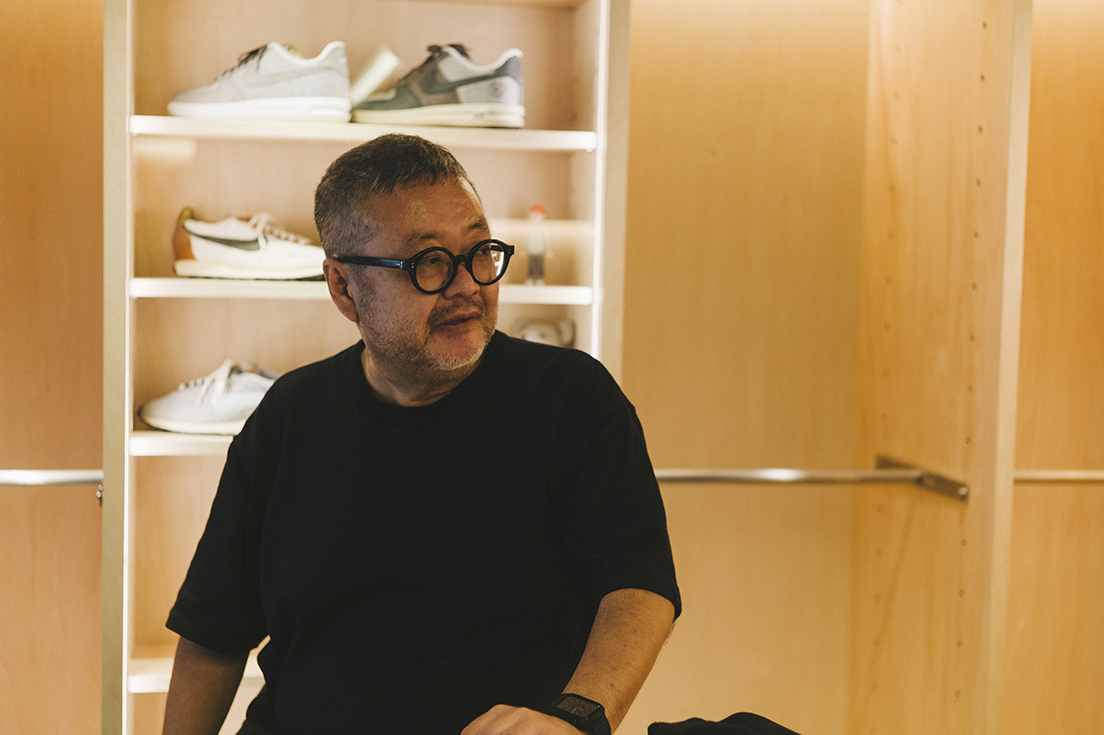
穴を開けられないほどの“千駄ヶ谷クオリティ”
―3人とも同じフィールドにいながら全く異なるタイプですよね。プロジェクトはどのように進んでいったんですか?
梶原:鈴木さんに話を持っていく前に小木君とどういうものにするかの話をして、小木君が持っているいろんな可能性の中でヴィンテージにフォーカスすることにしました。そしたら小木君が穴を開けたい、と。でも何十年着てもへたらない「LOOPWHEELER」の品質は魅力の一つだから鈴木さんは嫌がるんじゃないかなとか(笑)。それにヴィンテージ化する技術を使って鈴木さんの納得のいくクオリティに仕上げようとしたら、(上代が)10万円ぐらいになっちゃうから現実的じゃない。じゃあヴィンテージにフォーカスしながらどうするかをもう一度考え直して出来上がったのがコレです。
小木:デザイナーズアーカイブと呼ばれるものが今さらに注目される中で、ヴィンテージの注目度が更に高まっているんです。自分も買うんですが、当時のものは着丈が短かったり生地が分厚かったりして……。僕はヴィンテージマニアではないのでそういう要素を現代的に着たいんですが、なかなか無いんです。あとは海外出張に行かなくなって、改めて日本を見る機会が増えたんですが、“千駄ヶ谷クオリティ”(LOOPWHEELERの拠点である千駄ヶ谷には職人気質なアパレルメーカーが密集する)には頭をぶん殴られたような衝撃があって。そのクオリティでヴィンテージテイストのものを作ってみたかったんです。
―なぜ今、日本のもの作りに注目しているんですか?
小木:ラグジュアリーストリートの反動もあるかも知れないですね。今、「ビギン」とかに載っているものが新鮮に感じますし。僕はそこがすっぽり抜けていたんです。
鈴木:「ビギン」も「モノ・マガジン」もちょっと特殊なんです。昔は、「LOOPWHEELER」はどちらかというと他のファッション誌からはほとんどピックアップしていただけなかった。以前、デニムは5年、10年、15年と経年したものを並べるとビジュアルで変化が見て取れるけど、グレーの霜降りのスウェットを並べても分からない。だから誌面で説明するのは無理だと言われたことがあります。そんな感じで所謂ファッションを主戦場にする編集者さんやスタイリストさんとのご縁がどんどんなくなっていった時期がありました。最終的には表参道を歩いている人に手渡しして、ものの良さを知ってもらうのが一番のプロモーションになるんじゃないか?と思っていた頃に、「モノ・マガジン」の編集者と出会ったんです。それが2004年で、そこから少しずつ知ってもらえるようになりました。
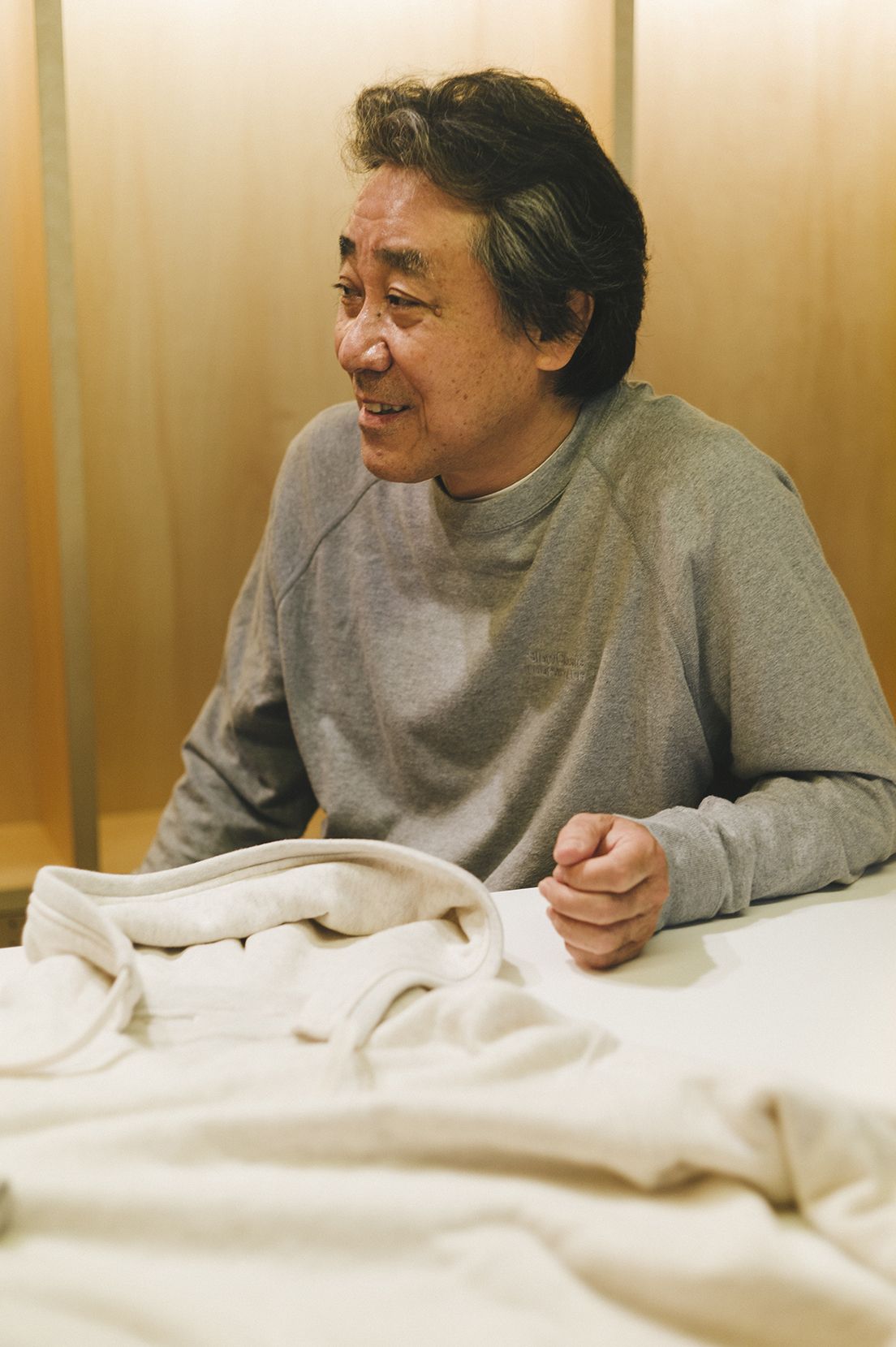
梶原:僕は何度もいろんなところで書いているんですけど、僕らの時代ってスウェットはアメリカが絶対正義だったので最初は「LOOPWHEELER」に興味がなかったんです。でも12年前に鈴木さんからスウェットをいただいて、こんな世界があるんだってのを初めて知った。
小木:梶原さんが「そのとき鈴木さんからいただいたスウェットを今でも着ているんですが、穴一つ空いてないんです。形もほとんど変わらなくて丈夫」ということをおっしゃっていて、やっぱり穴を開けるのは違うな、と。ネック周りを調整したり、細かいところまでこだわって、きちんとヴィンテージの代表的なディテールを入れています。サイズ感も大きくし過ぎると大人が着られないですし、ジャケットのインナーにも着たいので、「LOOPWHEELER」の通常のサイズよりもワンサイズ大きいものをアレンジしました。
3人の掛け合いから生まれた上品な後付けパーカ
鈴木:今POGGYちゃんが今日着ているものが元になったサンプルで、そこからサイズ感を調整したんだよね。後付けパーカはインラインでは作らないから、それを作りたいって言ってくれて嬉しかった。
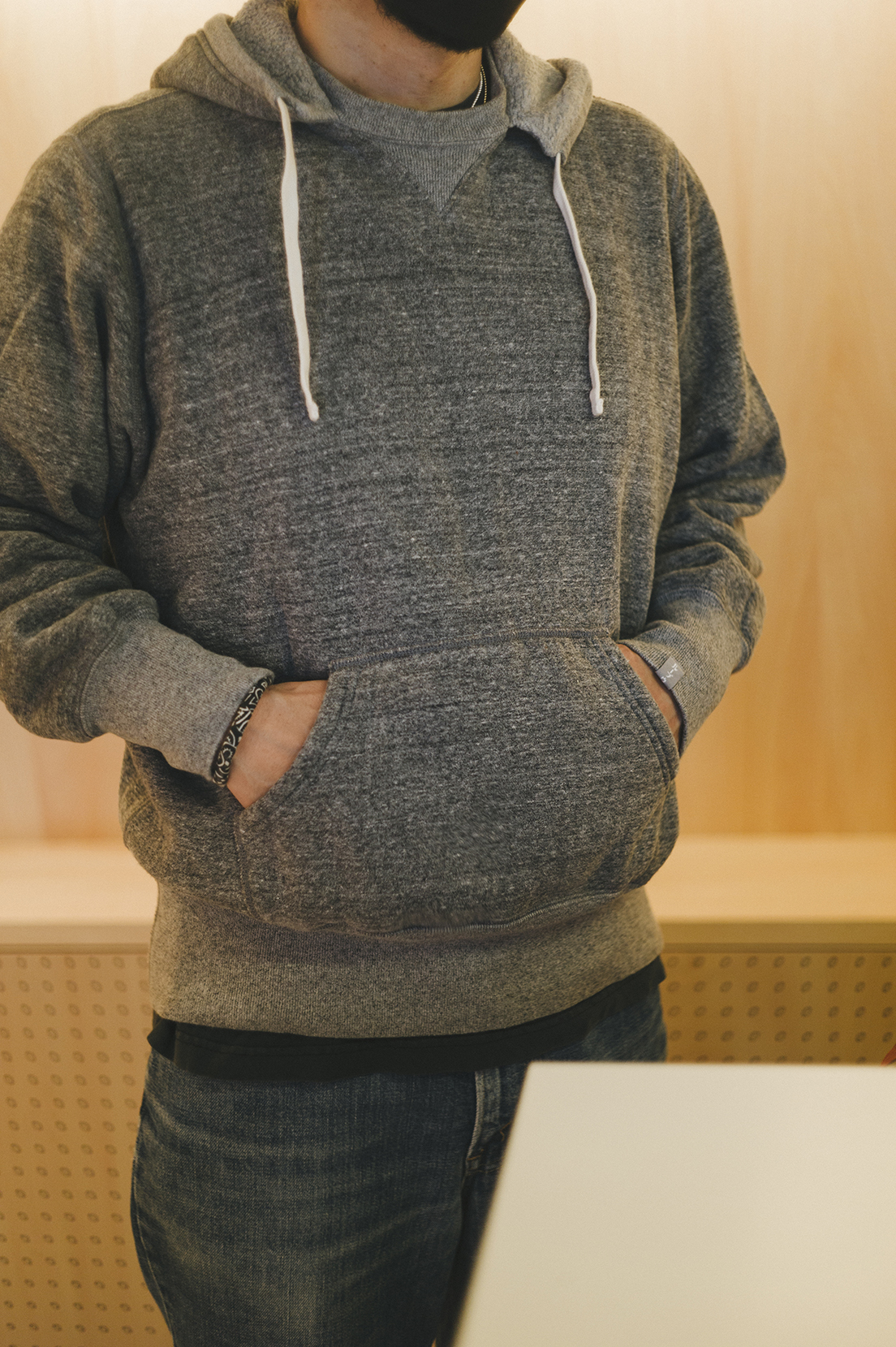
小木:こういう感じだと生地を厚めにしたり、ちょっとやりすぎてしまうところを梶原さんが誰でも着やすいようにストップをかけてくれるんです。僕は黒を普段着ないので、発想自体がないんですけど、梶原さんから黒もきちんと作った方がいいよとアドバイスをもらいました。
梶原:小木君って音楽に例えると“ミュージシャンが好きなミュージシャン”というか、通受けするミュージシャンなんですよ。洋服でもそういう人なんで、業界内の評価やファッションアイコンとしてはものすごい存在なんだけど、自分の好きなままやると誰もついて来れない(笑)。裏地の色を変えたいとかポケットを配色にするとかのアイデアもあったんだけど、今回は売れ筋を作ろう、と。それで2色のうち、1色はヴィンテージ色の強い色にして、もう1色は黒にしたんです。紐もヴィンテージ感を出すならフツウは白にするけど黒にしました。黒にすることで万能になるんです。
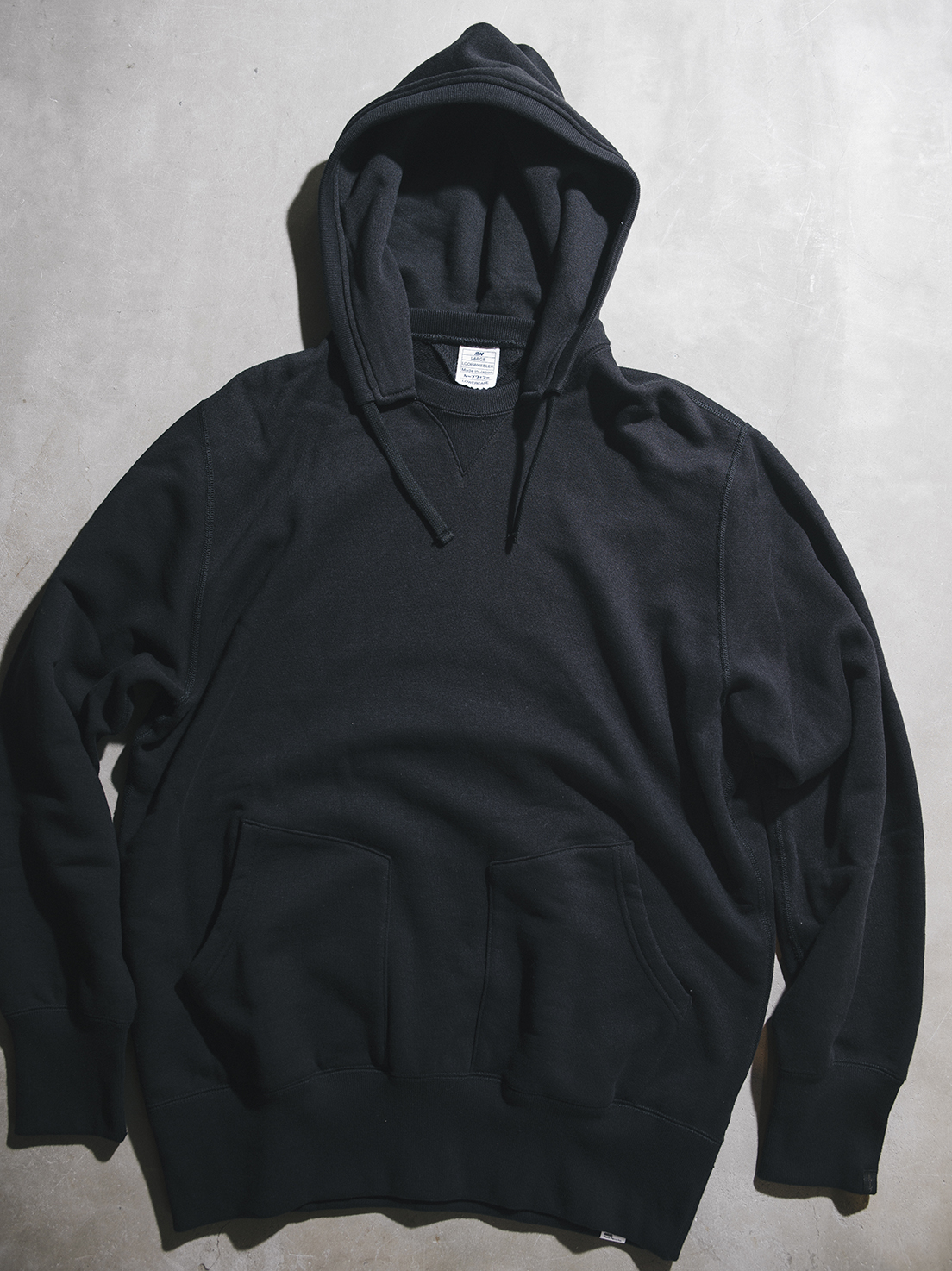
―なるほど。POGGYさんが後付けパーカに惹かれた理由は?
小木:単純に憧れです。ヴィンテージパーカの象徴なんですよね。
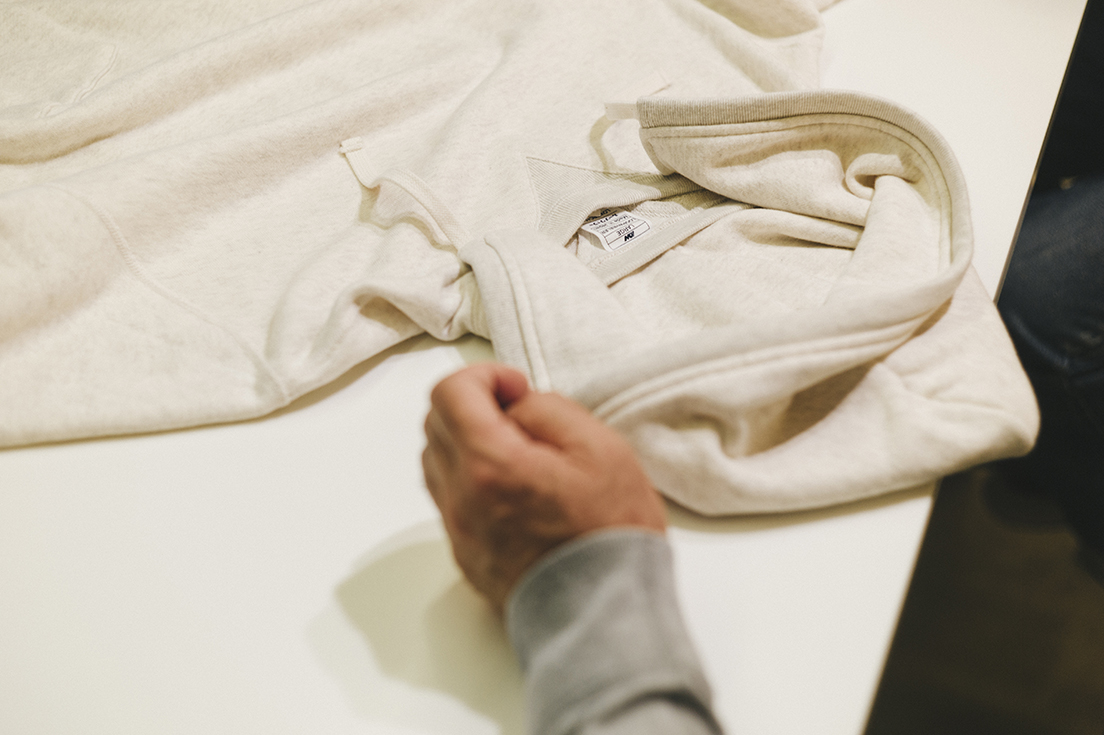
鈴木:後付けパーカが生まれた当時は、試行錯誤をした時代だったと思うんです。寒いからスウェットにただフードを付けちゃった。でもこれはめちゃめちゃ手間だし、当時の技術を見ると縫い目がめちゃめちゃ弱くて、ただ縫っているだけだから破れたものもたくさんある。当時は今みたいなカンガルーポケットの発想もないからパッチポケットになっていたり、リブも伸びなかったのでガゼットを前後につけたりしていたんです。
梶原:脇のフラットシーマもすごく綺麗です。
鈴木:フラットシーマは技術がいるので、普通はこんなに綺麗に縫えない。粗を探そうと思えば、そういう部分を見ていくと上手な工場か、そうじゃないかが分かる。基本の骨格をきちんと真面目にやればやるほど、繰り返し洗ったときに違いが出てきます。
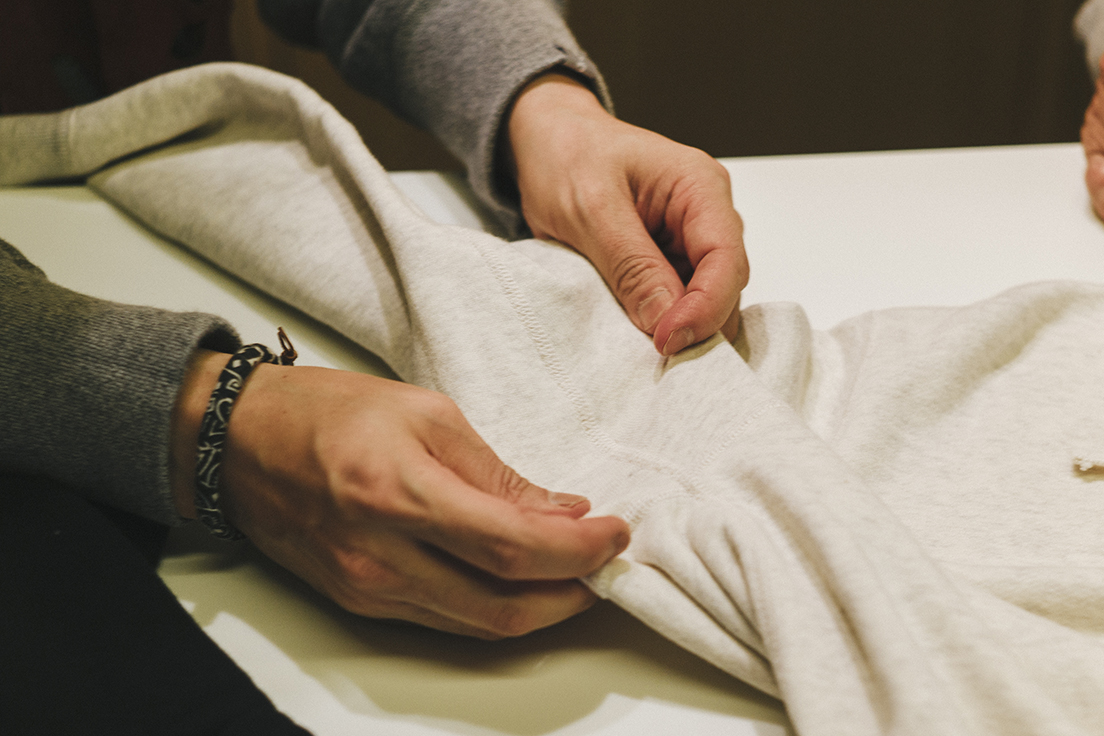
小木:鈴木さんがOEMとしていろんなブランドから注文を受けていたときに、日本のあるゴルフブランドが鈴木さんのが扱っていた吊り編み機で編まれた生地に目をつけたらしいんです。ゴルフ場はきちんとした格好をしないといけない場所だけど、カジュアルなのに品がある素材だからこれでスウェットを作れないか、と。それが大ヒットしたんですよね。
鈴木:90年代、僕が“振り屋(依頼によってもの作りを裏方でやらせてもらっていた)”をやっていた時代だね。POGGYちゃんから「鈴木さんはなんでストリートの人とも仲がいいんですか?」と聞かれるんですけど、常にニュートラルなんですよ。“もの作り屋”なので、自分たちができることならどんな仕事でも受ける。頼まれたクオリティとコストで納めるのが、僕の30代のときの仕事だったんです。
30年後も残るもの作り
―90年代に鈴木さんは裏原ブランドのスウェットも手掛けていたんですよね。
鈴木:当時、僕らが食べていけたのは、そのゴルフブランドと裏原が活況していたからですね。「HEAD POTER(ヘッドポーター)」には一番よくしてもらいました。吊り編み機で編む生地は僕自身も好きなので、裏原の人にお勧めはしていたんですけど、実はクイックに動けないんです。編むのに時間がかかるから「売れたから追加したい」と言われても4〜5カ月かかる。誰かが常に機械を回し続けない限り、ビジネスとしてのクイックな対応ができないから、吊り編みがダメになっていく理由はそれが一番大きいんです。そんなときに、ゴルフブランドが年間を通して定番でやってくれることになった。そのゴルフブランドは今でもすごく成長していますけど、その成長があったから機械を回し続けられました。
小木:ここ数年、90年代〜00年代の初頭の「SUPREME(シュプリーム)」や「UNDERCOVER(アンダーカバー)」のようなストリート発のブランドのアーカイブが盛り上がってきているんですけど、鈴木さんみたいな方が裏方にいたからこそ、今でも当時のものがきちんと残っているんだと思うんです。そういう人と一緒にもの作りができるのはすごく嬉しいですね。今回作ったものも30年後に残っている可能性もあるわけじゃないですか。
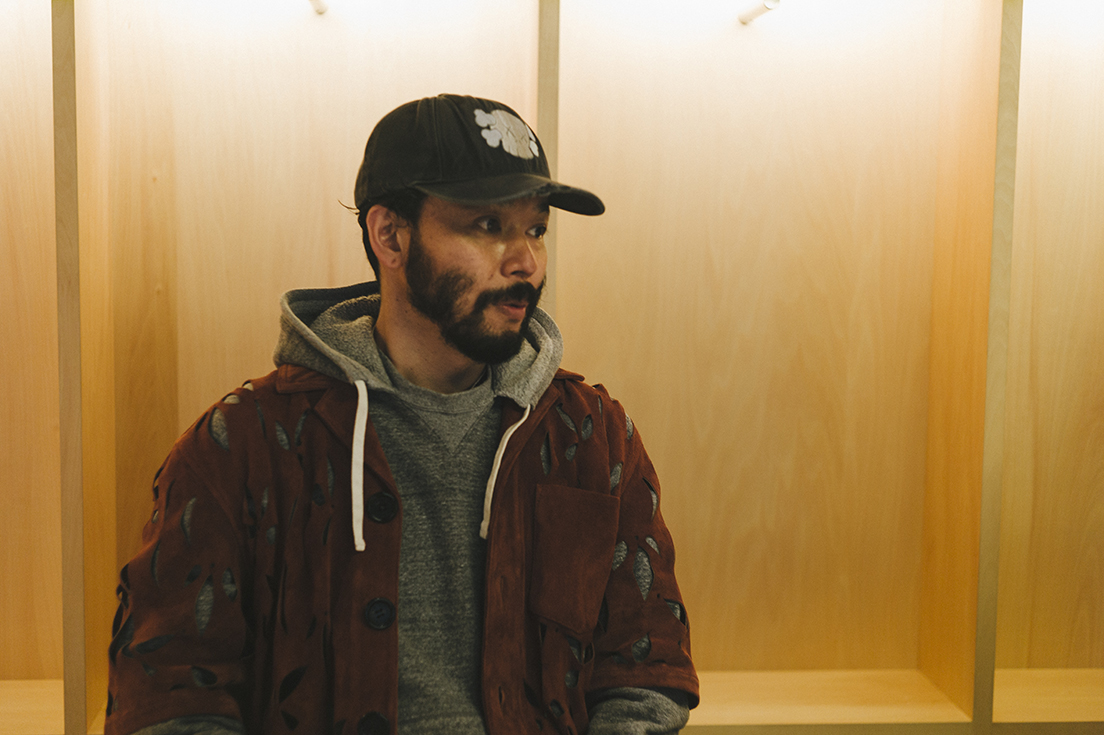
―最後に、3人で初めてもの作りをしてどうでしたか?
小木:今は日本にも素晴らしい20代のデザイナーが出てきていて、今度は自分が若いブランドを応援しなきゃいけないなと、改めて梶原さんや鈴木さんから学びました。自分が先輩達からやってもらったことを次は若い世代につなげたいと思います。
鈴木:逆に僕も学びがあって、それでまた僕自身が成長できる。この年齢になると怒られることも無くなるので仕事を通して学べるというは本当に貴重だと思います。
梶原:僕は、自分のアイデアを鈴木さんに作ってもらうやり方をこれまでして来なかったんですね。それは「LOOPWHEELER」のもの作りの延長上にないと意味がないと考えているから。だから今回も土台があって、そこに少し味付けするだけ。鈴木さんの方で具現化いただき、僕は着心地のこととかを言っているだけなんです。小木君の発想だったり、鈴木さんの具現化する力のおかげで、僕が着たいものを作れました。
鈴木:自分が着たいなと思うものを作らないと、ですよね。いつか「LOOPWHEELER」らしいものづくりではなく、梶原さんやPOGGYちゃんの純粋に作りたいものを作ってもらって、うちの店で売る企画ができたらいいなぁ。それぞれの好きなようにしてもらって。
小木:「LOOPWHEELER」に“穴を開ける”のは諦めていたんですが、まだ可能性があるかも知れませんね(笑)。
LOOPWHEELER × LOWERCASE × POGGYTHEMAN
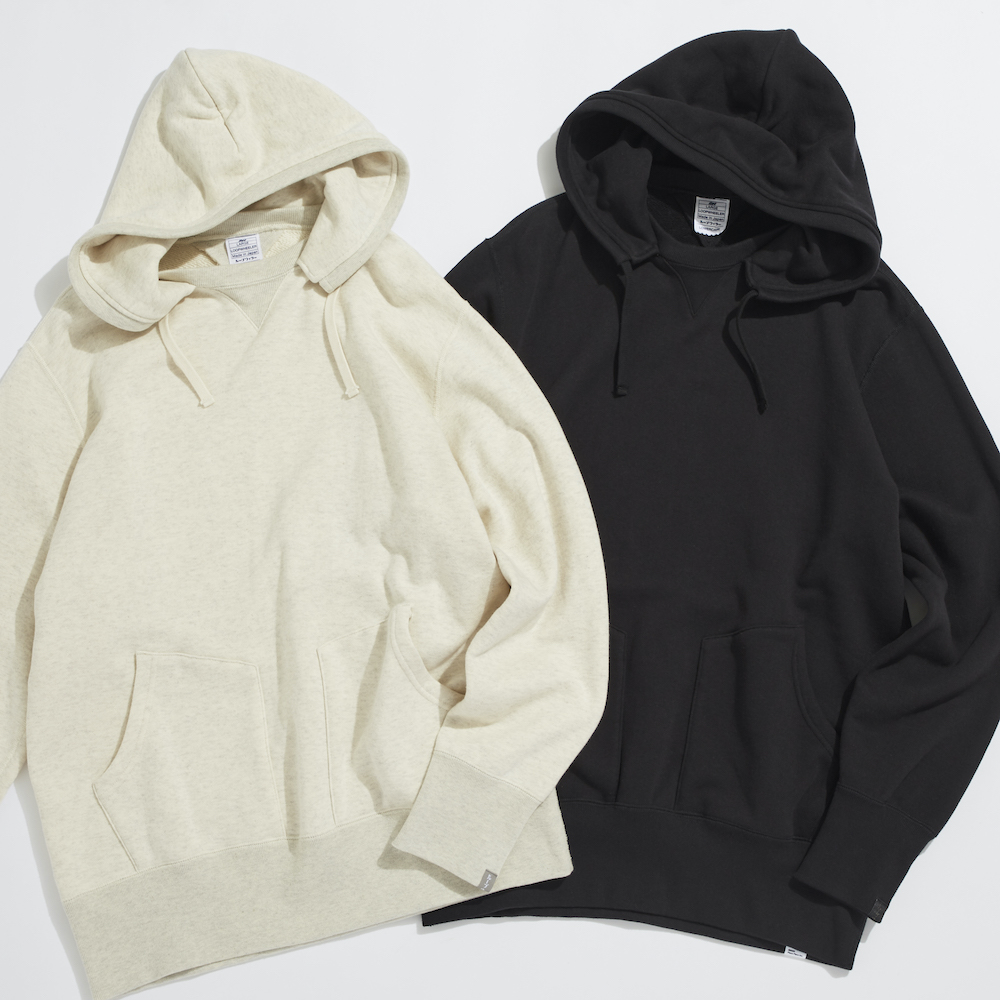
価格:¥23,100(税込)
サイズ:S・M・L・XL (オートミール) / M・L・XL (ブラック)
発売日:9月3日(金)
発売店舗:ユナイテッドアローズ&サンズ、ユナイテッドアローズ&サンズ オンラインストア(オートミール)、アダム エ ロペ オム取り扱い店舗(ブラック)
- Keywords:


